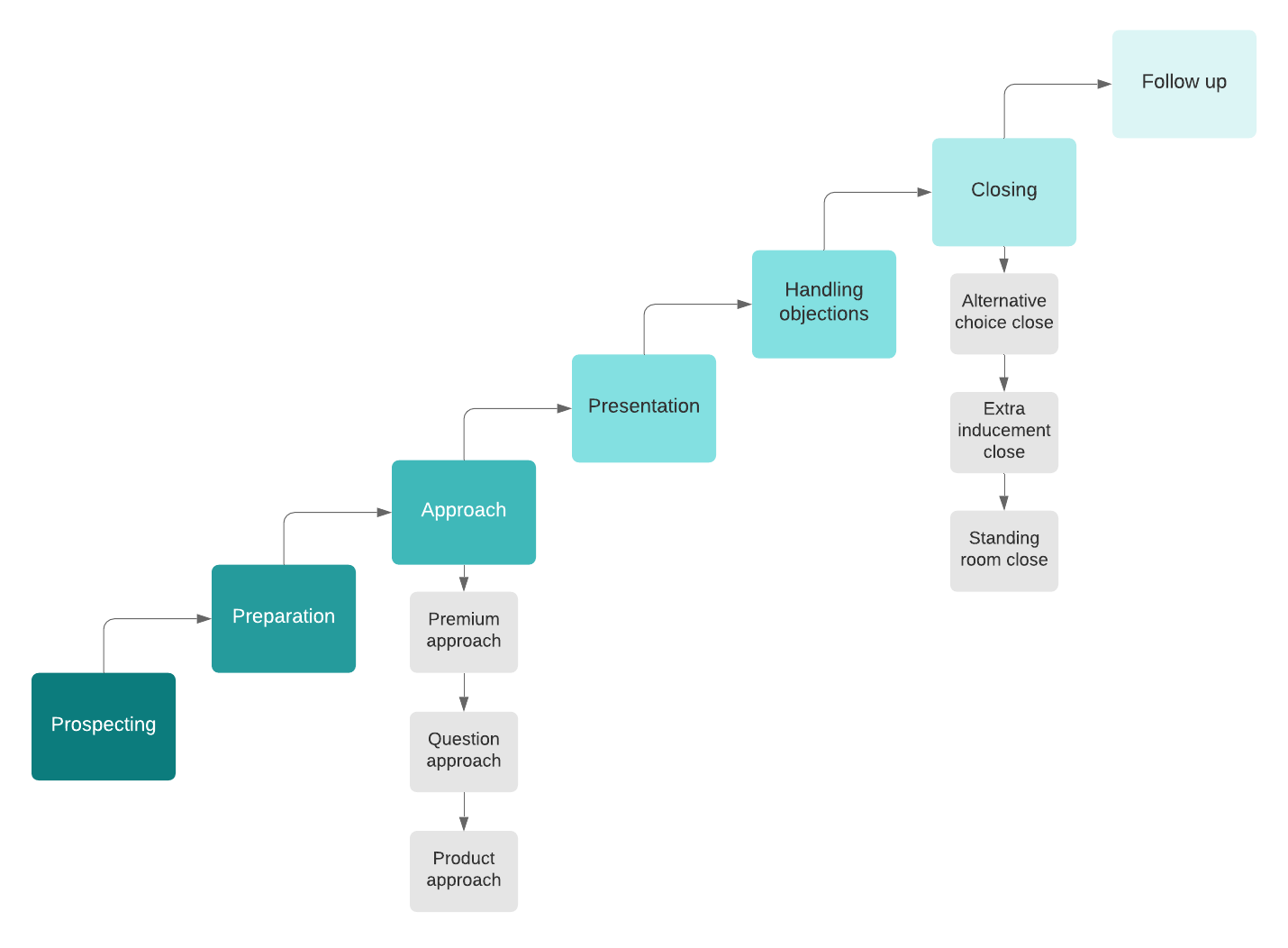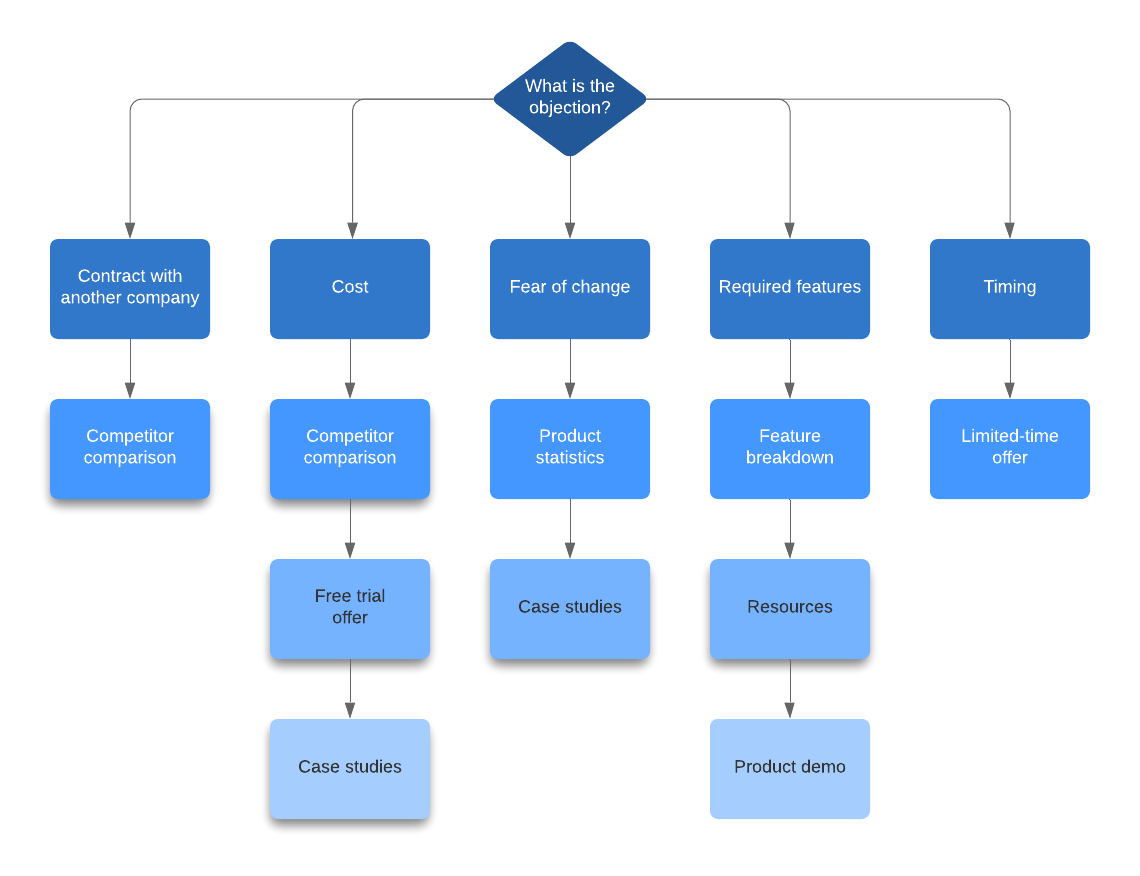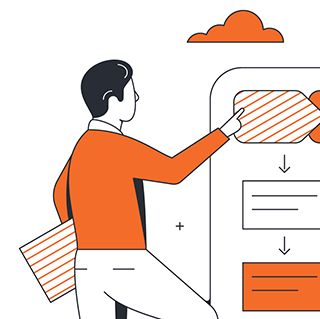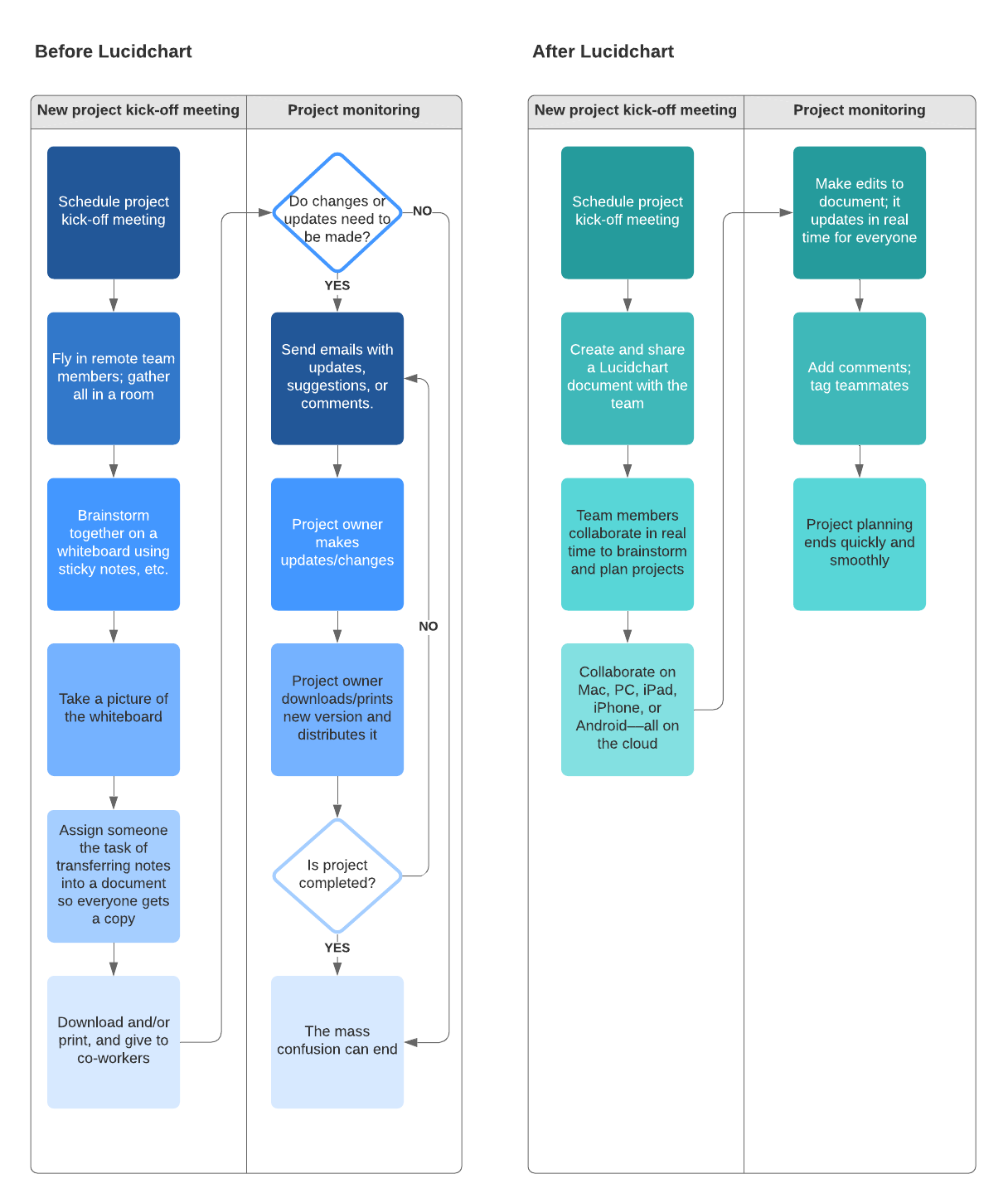
7-step sales process: When to use it and when to break it
Lucid Content
Reading time: about 6 min
Topics:
The 7-step sales process
If you are one of the 2.5 million employees in the United States working in sales, you know that even for the most natural salesperson, it can sometimes be difficult to turn potential leads into closed sales. Across industries, you need different skills and knowledge to prove to your potential customers that your solution is best for their particular problem.
The seven-step sales process outlined in business textbooks is a good start, especially since leading sales ops teams attribute to 60% or more of their total pipeline in any quarter to actively designed and deployed sales plays. The seven-step sales process is not only a good start to customizing it to your particular business but more importantly, customizing it to your target customers as you move them through the sales funnel.

As the old adage goes, “Learn the rules like a pro so you can break them like an artist.” Once you’ve mastered the seven steps of the sales process you might learn in a business class or sales seminar, then you can break the rules where necessary to create a sales process that may not necessarily follow procedure but gets results.
The textbook 7-step sales process
What are the seven steps of the sales process according to most sales masters? The following steps provide a good outline for what you should be doing to find potential customers, close the sale, and retain your clients for repeat business and referrals in the future.
1. Prospecting
The first step in the sales process is prospecting. In this stage, you find potential customers and determine whether they have a need for your product or service—and whether they can afford what you offer. Evaluating whether the customers need your product or service and can afford it is known as qualifying.
Keep in mind that, in modern sales, it's not enough to find one prospect at a company: There are an average of 6.8 customer stakeholders involved in a typical purchase, so you'll want to practice multi-threading, or connecting with multiple decision-makers on the purchasing side. Account maps are an effective way of identifying these buyers.
2. Preparation
The next step is preparing for initial contact with a potential customer, researching the market and collecting all relevant information regarding your product or service. Develop your sales presentation and tailor it to your potential client’s particular needs. Preparation is key to setting you up for success. The better you understand your prospect and their needs, the better you can address their objections and set yourself apart from the competition.
3. Approach
Next, make first contact with your client. This is called the approach. Sometimes this is a face-to-face meeting, sometimes it’s over the phone. There are three common approach methods.
- Premium approach: Presenting your potential client with a gift at the beginning of your interaction
- Question approach: Asking a question to get the prospect interested
- Product approach: Giving the prospect a sample or a free trial to review and evaluate your service

Dive deeper into the various sales approaches you can use to start a relationship off on the right foot.
Learn more4. Presentation
In the presentation phase, you actively demonstrate how your product or service meets the needs of your potential customer. The word presentation implies using PowerPoint and giving a salesy spiel, but it doesn’t always have to be that way—you should actively listen to your customer’s needs and then act and respond accordingly.
5. Handling objections
Perhaps the most underrated step of the sales process is handling objections. This is where you listen to your prospect’s concerns and address them. It’s also where many unsuccessful salespeople drop out of the process—44% of salespeople abandoning pursuit after one rejection, 22% after two rejections, 14% after three, and 12% after four, even though 80% of sales require at least five follow-ups to convert. Successfully handling objections and alleviating concerns separates good salespeople from bad and great from good.

6. Closing
In the closing stage, you get the decision from the client to move forward. Depending on your business, you might try one of these three closing techniques.
- Alternative choice close: Assuming the sale and offering the prospect a choice, where both options close the sale—for example, “Will you be paying the whole fee up front or in installments?” or “Will that be cash or charge?”
- Extra inducement close: Offering something extra to get the prospect to close, such as a free month of service or a discount
- Standing room only close: Creating urgency by expressing that time is of the essence—for example, “The price will be going up after this month” or “We only have six spots left”
7. Follow-up
Once you have closed the sale, your job is not done. The follow-up stage keeps you in contact with customers you have closed, not only for potential repeat business but for referrals as well. And since retaining current customers is six to seven times less costly than acquiring new ones, maintaining relationships is key.

Want to nail the sales follow-up process? Follow our tips.
Read moreSales process takeaways: What’s important?
Now that you understand the basic seven stages of sales process development, you can begin to tailor them to your own product or service and customer base. Cut out steps that are unnecessary to your particular business and focus on your customer. You know the rules—now get ready to break them in ways that bring you closer to your customer and turn you from a sales professional to a sales artist.
Whatever approach you take, keep these fundamentals in mind:
Identifying the customer’s problem
You have a product or service you want to sell—now what? Anyone with a problem related to your area of expertise can be a potential customer. You'll need to dive deep into discovery work to learn each buyer's specific goals, needs, and pain points.
Develop a solution for the customer
Once you have uncovered problems for your products to solve, tailor your offerings to fix those issues—and be prepared to explain how your product truly is a solution for the given problems. Sales engineers can use Lucidchart to visually demonstrate how their product or service solves client problems and makes their lives easier, such as the flowchart below.

Be persistent
Following up isn’t just for after the close to get repeat business. As stated before, most customers don’t buy right away. You have to handle objections and try, try, try again. This is where the seven-step sales process doesn’t account for repeated approaches, presentations, meetings, or phone calls where you handle objections. If it did, it might be a 13-step sales process or a 21-step sales process, or… you get the idea.
Bottom line: stay connected—set up a calendar for repeated contact with potential, present, and past customers so you're more likely to reach them when they're ready to buy.
What are the key steps in the sales process? Whatever your customers need them to be.
Once you’ve tried out a few different approaches, tweaking the original seven steps in the sales process to fit your customers better, document your successes so that you can follow the steps that work best and easily get new reps up to speed as they are onboarded.

Whatever steps you settle on, you need to document your sales process to ensure that sales reps follow it. Learn about sales process mapping.
Read moreAbout Lucidchart
Lucidchart, a cloud-based intelligent diagramming application, is a core component of Lucid Software's Visual Collaboration Suite. This intuitive, cloud-based solution empowers teams to collaborate in real-time to build flowcharts, mockups, UML diagrams, customer journey maps, and more. Lucidchart propels teams forward to build the future faster. Lucid is proud to serve top businesses around the world, including customers such as Google, GE, and NBC Universal, and 99% of the Fortune 500. Lucid partners with industry leaders, including Google, Atlassian, and Microsoft. Since its founding, Lucid has received numerous awards for its products, business, and workplace culture. For more information, visit lucidchart.com.
Related articles
9 Sales Lessons From Hollywood
Aristotle and the ancient Greeks believed that viewing good art, especially drama, helped individuals to learn about themselves and purify suboptimal habits from their lives. This methodology is also used in the modern era and can be applied to professionals of all sorts including salespeople. In the spirit of Aristotle’s philosophy (known as catharsis, in case you were wondering), here are nine quotes from modern cinema intended to help you evaluate your sales habits and become a rockstar closer.
How to Have Meaningful Conversations That Triple Your Sales
One of the biggest problems I faced as a new inside sales rep was how to have a conversation that resonated with my buyer. After diving into the structure of my calls with my manager, we found that my calls were more of the interrogation approach, asking closed-ended questions. If there is one major piece of advice I can give, it is to learn from my failure.
